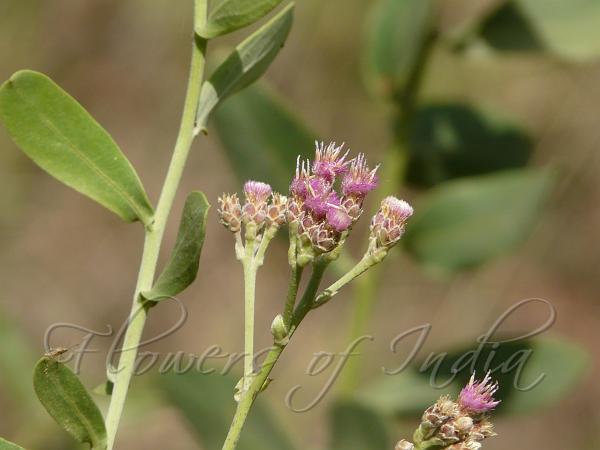|
| Rasna |
|

|

| File size | 2019292 |
| Original date | 5/26/08 3:10 PM |
| Resolution | 2560 x 1920 |
| Flash | Flash did not fire, auto |
| Focal length | 82.8mm |
| Exposure time | 1/400s |
| Aperture | 6.3 |
| Focus Distance | |
| Metering Mode | Multi-segment |
| Camera make | Panasonic |
| Camera model | DMC-FZ18 |
| Sensor type | OneChipColorArea |
|
|
|
|
Photo: |
Botanical name: Pluchea lanceolata Family: Asteraceae (Sunflower family)
Synonyms: Berthelotia lanceolata
Synonyms: Berthelotia lanceolata
Rasna is an undershrub, growing up to 1.5 m tall, with whitish or greyish branches. Leaves are sessile, 1-7 cm long, 0.3-2 cm wide, oblong-invert-ed-lanceshaped, with a tiny point at the tip, leathery, minutely velvety on both surfaces. Margin is entire or obscurely toothed at the tip. Flower-heads are purplish, ovoid or bell-shaped, 3-5 mm in diameter,
arranged in compound corymbs at the end of branches. Phyllaries are 2-3
seriate, outer ones purple tinged at the apex, broadly, obovate, obtuse,
entire, pubescent, 2.5-3.5 mm long, silky pubescent, inner linear entire,
4-6 mm long. Florets are pink, outer female florets many, thread-like,
disc florets tubular, few, 4-18, bisexual but functionally male. The
one-seeded fruit is small, white, linear, hairless. Pappus hairs 20-26,
distinctly fused at base. Flowering: March-August.
Medicinal uses: Rasna is a medicinal herb in Ayurveda and
Tibetan medicine. The plant is used for the
inflammations and bronchitis, psoriasis, cough and piles. It is also used
as antipyretic, analgesic, laxative and nervine tonic. The decoction of
plant is used to prevent the swellings of joint in arthritis, rheumatism
and neurological diseases. The roots are antipyretic, bitter, laxative and
thermogenic and are used for allaying the pain caused by the sting of
scorpions.
Rasna is a medicinal herb in Ayurveda and
Tibetan medicine. The plant is used for the
inflammations and bronchitis, psoriasis, cough and piles. It is also used
as antipyretic, analgesic, laxative and nervine tonic. The decoction of
plant is used to prevent the swellings of joint in arthritis, rheumatism
and neurological diseases. The roots are antipyretic, bitter, laxative and
thermogenic and are used for allaying the pain caused by the sting of
scorpions.
Medicinal uses:
 Rasna is a medicinal herb in Ayurveda and
Tibetan medicine. The plant is used for the
inflammations and bronchitis, psoriasis, cough and piles. It is also used
as antipyretic, analgesic, laxative and nervine tonic. The decoction of
plant is used to prevent the swellings of joint in arthritis, rheumatism
and neurological diseases. The roots are antipyretic, bitter, laxative and
thermogenic and are used for allaying the pain caused by the sting of
scorpions.
Rasna is a medicinal herb in Ayurveda and
Tibetan medicine. The plant is used for the
inflammations and bronchitis, psoriasis, cough and piles. It is also used
as antipyretic, analgesic, laxative and nervine tonic. The decoction of
plant is used to prevent the swellings of joint in arthritis, rheumatism
and neurological diseases. The roots are antipyretic, bitter, laxative and
thermogenic and are used for allaying the pain caused by the sting of
scorpions. | Identification credit: K. Ravikumar | Photographed in Hauz Rani City Forest, Delhi. |
• Is this flower misidentified? If yes,